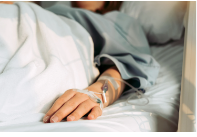Many patients with serious brain injuries may be more conscious than previously believed, according to scan results.
In cases where a patient has suffered a brain damage and is not responding, medical professionals do simple tests such as calling the patient’s name, clapping in close proximity to their ear, or sticking a cotton swab under their nose to check for consciousness.

People who don’t wake up are frequently thought to have passed out.
However, a recent research indicates that 25% of people with brain injuries may be responding to directives intellectually rather than physically. This week, the New England Journal of Medicine published the findings.
The study examined 353 individuals who appeared to have lost consciousness as a result of a brain damage from the outside. These injuries came from a variety of sources, including heart attacks, strokes, and accidents. 241 of those patients were determined to be either minimally aware, in a vegetative state, or in a coma.
The patients were verbally instructed to open and close their hands or to see themselves swimming by the researchers. There was evidence that 60 out of the 241 patients could still do certain activities mentally. This is known in the study as “cognitive motor dissociation.” “Covert awareness” is a word that certain clinicians favor.

According to Weill Cornell Medicine neurologist Dr. Nicholas Schiff, who is also one of the study’s authors, even some of the other patients who had recovered sufficiently to physically respond to verbal prompts were unable to complete the mentally taxing activities.
The results imply that hidden awareness is more prevalent than previously believed. Previous small studies showed that 10%–20% of individuals who were unresponsive had covert awareness. The current research is bigger than the earlier ones.
Assistant director of the Casa Colina Research Institute Caroline Schnakers, who investigates the same phenomena but was not involved in the current research, called it “an incredible finding, but also kind of scary.”
It is quite concerning for physicians, she added, that so many patients “could be able to at least respond to their environment, but are not given the right tools for doing so.”
According to Schiff, a conservative estimate would be one in four cases.
He remarked, “We know we missed people.” It is also known that individuals with serious brain injuries have arousal swings. Every day has its ups and downs for them.
His team used functional MRIs and brain wave testing to gauge the patients’ mental activity. A functional MRI analyzes blood flow to determine brain activity in the brain as opposed to a regular MRI, which creates three-dimensional pictures of the brain. Certain parts of the brain light up and receive greater blood flow when aware individuals are instructed to follow a directive.
However, not all hospitals have this equipment, thus physicians might not diagnose patients correctly. In addition to physical examinations, several hospitals employ CAT scans or routine MRIs to assess a patient’s mental state. Medical professionals might mistakenly believe there is no chance for recovery if such tests reveal no evidence of awareness.
Schiff declared, “They’re going to be treated as if they’re completely unresponsive.” “No one will be able to figure out that they are there.”
One research restriction was brought up by Dr. David Greer, chief of the neurology department at Boston University School of Medicine: not every patient had the same degree of brain dysfunction or damage.
Greer, who was not engaged in the research, stated, “I think that has to be a caveat, because it’s a fairly heterogeneous group.”
But according to Schiff, brain damage is often consistent across different types of accidents.
Young patients and those with traumatic brain injuries (the sort associated with outside occurrences like falls or vehicle collisions) were more likely than other patient demographics in his research to have hidden awareness.
Those with traumatic brain injuries “are notorious for looking really bad for weeks or even months, and then at six or twelve months, they have a remarkable delayed recovery,” according to Greer. “I always exercise extreme caution with those to ensure that I’m not drawing any hasty conclusions.”
However, he pointed out that a patient’s ability to return to their regular lives is not certain, even if they are cognizant.
“The worst thing that families can learn from this is to assume that they’re in there and will fully recover,” Greer stated. “I believe that giving families false hope of that kind would be very misleading, as the majority, if not all, of these patients will still have a severe disability.”
However, the results do provide optimism for the future—namely, for matching patients to specific therapies. Right now, there aren’t many options: Amantadine, a medication used to treat Parkinson’s disease, has some potential to aid with awareness recovery. Additionally, some physicians recommend stimulants, antidepressants, or Ambien.

The next generation of therapies may include brain implants or neuromodulation, which modifies brain function with electrical currents, according to Schnakers. She underlined the significance of giving families choices for their cherished ones.
“What can we do?’ the family will inquire. Actually, we haven’t given it any thought,” she remarked, adding, “This isn’t acceptable anymore.”





